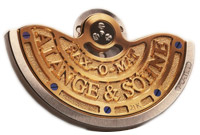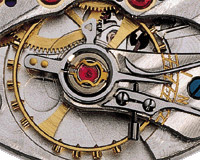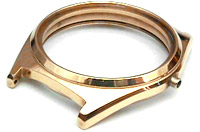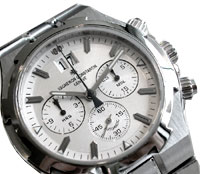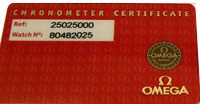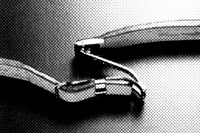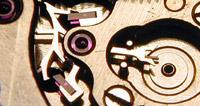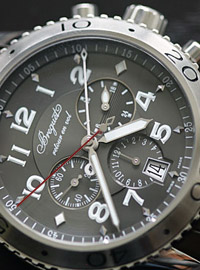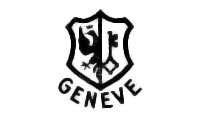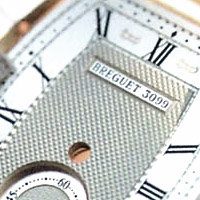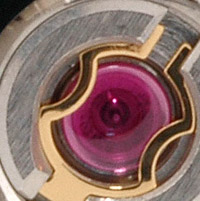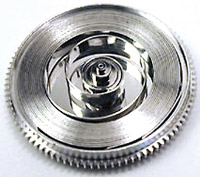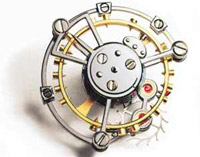Watch Parts
Aperture
Small opening. The dials of some watches (in French: montres à guichet) have apertures in which certain
indications are given (e.g. the date, the hour, etc).
Applique
Applique or applied characters are numerals or symbols cut out of sheet metal and stuck or riveted to a dial.
Assembling
Process of fitting together the components of a movement. This was formerly done entirely by hand, but
the operations have now been largely automated. Nevertheless, the human element is still primordial,
especially for inspection and testing.
Assortiment
French term for the parts used for making an escapement.
Automatic Watch
A watch whose mainspring is wound by the movements or accelerations of the wearer's arm. On the
basis of the principle of terrestrial attraction, a rotor turns and transmits its energy to the
spring by means of an appropriate mechanism. The system was invented in Switzerland by Abraham-Louis
Perrelet in the 18th century.
« The beautifully decorated rotor from an automatic watch by A. Lange and Sohne.
Balance
Moving part, usually circular, oscillating about its axis of rotation. The hairspring coupled to it
makes it swing to and fro, dividing time into exactly equal parts. Each of the to-and-fro movements
of the balance ("tick-tack") is called an "oscillation". One oscillation is composed of two vibrations.
« The delicate and exquisite balance of a Glashutte watch.
Bar, lug
In wristwatch-cases, a thin metal rod fixed between the horns, for attaching the wristlet.
Barrel
Thin cylindrical box containing the mainspring of a watch. The toothed rim of the barrel drives the train.
Bridge
Complementary part fixed to the main plate to form the frame of a watch movement. The other parts
are mounted inside the frame (part of the "ébauche").
« A close-up of the barrel bridge on a Girard Perregaux three bridge movement.
Calibre
Originally used to mean the size of a watch movement, this term now denotes a type of movement
(men's calibre, automatic calibre, etc). When a calibre number is accompanied by the manufacturer's
mark, it serves as an indication of origin.
(Watch-)Case
Container that protects the watch-movement from dust, damp and shocks. It also gives the watch as attractive
an appearance as possible, subject to fashion and the taste of the public.
Casing (Up)
Process of inserting and fixing a watch movement into its case.
Chablon
French term for a watch movement (not including the dial and hands), of which all or part of the
components are not assembled.
Chronograph
Watch or other apparatus with two independent time systems: one indicates the time of day, and the other
measures brief intervals of time. Counters registering seconds, minutes and hours can be started and
stopped as desired. It is therefore possible to measure the exact duration of a phenomenon. The term
chronograph is often confused with the similar but very different term, 'chronometer'. Chronographs
generally have a start/stop pusher and reset pusher. One touch of the start/stop pusher activates the
(usually) separate chronograph hand. A second touch of the start/stop pusher stops the chronograph.
Many chronographs usually measure durations as long as 12 hours, 29 minutes and 59 seconds.
Chronometer
Watch which has undergone a series of precision tests in an official institute. The requirements are very
severe: a few seconds per day in the most unfavourable temperature conditions (for mechanical watches) and
positions that are ordinarily encountered. If the watch passes these tests, it is awarded with an official
certificate verifying its ability to maintain accurate time in various positions. Once awarded a COSC
certification, each watch manufacturer produces its own branded certificate.
Crown
Knurled knob located on the outside of a watch case and used for winding the mainspring. It is also used
for setting the hands to the right time and for correcting thecalendar indications.
Date
Ordinal number referring to a day of the month: the 10th February. Date-watch: watch indicating the date,
the month and sometimes the year and the phases of the moon. Also called a calendar-watch or calendar.
Perpetual calendar: watch indicating leap years as well as the date.
Deployant
This clasp mechanism found on most high-end watches derives its name from the French adjective
Deployant - which means to unfold, unfurl or spread out. Commonly and mistakenly called Deployment,
the Deployant clasp is an expanding metal clasp that permits both metal and fabric bracelets to close
invisibly around the wrist.
« The deployant clasp on a leather strap.
Dial
Indicating "face" or plate of metal or other material, bearing various markings to show, in ordinary
watches and clocks, the hours, minutes and seconds. Dials vary verymuch in shape, decoration, material,
etc. The indications are given by means of numerals, divisions or symbols of various types.
Direct Drive
Refers to a seconds-hand that moves forwards in little jerks. Trotteuse, French term for a direct-drive
seconds-hand, especially a centre seconds-hand.
Display
Indication of time or other data, either by means of hands moving over a dial (analogue display) or by
means of numerals appearing in one or more windows (digital or numerical display); these numerals may be
completed by alphabetical indications (alphanumerical display) or by signs of any other kind. Example:
12.05 MO 12.3 = 12 hours, 5 minutes, Monday 12th March. Such displays can be obtained by mechanicalor
electronic means.
Ebauche
French term (but commonly used in English-speaking countries) for a movement blank, i.e. an incomplete
watch movement which is sold as a set of loose parts, comprising the main plate, the bridges, the train,
the winding and setting mechanism and the regulator. The timing system, the escapement and the mainspring,
however, are not parts of the "ébauche".
Escapement
Set of parts (escape wheel, lever, roller) which converts the rotary motion of the train into
to-and-fro motion (the balance).
« The escape wheel and anchor.
Etablissage
French term for the method of manufacturing watches and/or movements by assembling their various
components. It generally includes the following operations: receipt, inspection and stocking of the
"ébauche", the regulating elements and the other parts of the movement and of the make-up; assembling;
springing and timing; fitting the dial and hands; casing; final inspection before packing and
dispatching.
Etablisseur
French term for a watch factory which is engaged only in assembling watches, without itself producing
the components, which it buys from specialist suppliers.
Factory, works
In the Swiss watch industry, the term manufacture is used of a factory in which watches are manufactured
almost completely, as distinct from an "atelier de terminage", which is concerned only with assembling,
timing, fitting the hands and casing.
Fly-Back Hand
In a flyback chronograph (often refered to as 'retour-en-vol'), the centre second hand may be stopped,
reset to zero, and restarted with a single push of one of the chronographic pushpieces. Unlike
traditional chronographs, the fly-back maintains timekeeping accuracy. No time is lost while the
seconds hand returns to the zero position. The chronograph maintains the elapsed time during the
reset and records the accurate transpired time on the dial. The flyback feature is particularly
useful where timing accuracy must be maintained between timed tasks.
« The Breguet Type XXI flyback chronograph is a beautiful example
of the useful flyback feature. The chronograph center seconds hand has been colored red for
illustration purposes.
Geneva Seal
Created in the 19th century by a guild plagued by counterfeit products, the Geneva Seal is currently
considered to be the symbol of watch-making perfection. Enacted into law in 1886, the Geneva Seal is
probably one of the oldest professional labels, recognised both as an indication of independent origin
and a guarantee of superior quality. Three prerequisites determine the award of the Geneva Seal:
The movement must be mechanical and, at a minimum, assembled and adjusted in the canton of Geneva.
Each calibre must meet twelve technical and aesthetic criteria outlined in the regulations, which have
a bearing on its design and characteristics as well as the quality of the manufacture and finishes.
The caliber must be approved and officially recognised by the Office for the Voluntary Inspection of
Watches from Geneva (Bureau de Contrôle Facultatif des Montres de l'Etat de Genève). This Office is
supervised by a sworn-in commission composed of members that have been appointed by the government
of the canton.
Glass, Crystal
Thin plate of glass or transparent synthetic material (usually synthesized sapphire), for protecting
the dials of watches, clocks, etc.
Guilloché
Guilloché is an ornamental dial pattern that repeats itself. It may or may not be hand-decorated.
In addition to being used to protect against forgery, these beautiful patterns have been used for
centuries to decorate valuable timepieces.
Hand
Indicator, usually made of a thin, light piece of metal, very variable in form, which moves over a
graduated dial or scale. Watches usually have three hands showing the hours, minutes and seconds.
Incabloc
Incabloc is a trademarked term refering to the shock-absorbing mechanism of the same name, used
in mechanical wristwatches to prevent damage to sensitive parts during a flat or lateral fall. It
efficiently protects the pivots and balance-jewels by keeping the distance between the jewels
constant.
« The incabloc mechanism showing the gold-colored Incabloc spring
Jewel
Bearing, endstone or pallet used for reducing friction. Generally made of synthetic material,
except for the precious or semi-precious stones (ruby, sapphire, garnet) which are sometimes
used in "de luxe" watches.
Main Plate
Base plate on which all the other parts of a watch movement are mounted (part of the "ébauche").
Mainspring
The mainspring stores winding energy to operate the watch between windings. It is a long strip of
hardened blued or alloyed steel, approximately 200-300 millimeters in length and 0.05-0.2 millimeters
in thickness. The mainspring is coiled inside the barrel and enables most contemporary mechanical
watches to run for 36 to 40 hours. Today's mainsprings are highly elastic. They are almost
impervious to breakage or permanent bending. Some mainsprings are even non-magnetic.
« The mainspring tightly wound inside its barrel.
Manufacture d'horlogerie
French term for a watch factory which itself produces the components (particularly the "ébauches")
needed for the manufacture of its products (watches, alarm and desk clocks, etc).
Marine Chronometer
Highly accurate mechanical or electronic timekeeper enclosed in a box (hence the term box chronometer),
used for determining the longitude on board ship.Marine chronometers with mechanical movements are
mounted on gimbals so that they remain in the horizontal position is necessary for their precision.
Middle(of watch-case)
Middle part of the case, in which the movement is fitted.
Movement
Assembly consisting of the principal elements and mechanisms of a watch or clock: the winding and
setting mechanism, the mainspring, the train, the escapement, the regulating elements. "Anatomically",
the movement consists of the "ébauche", the regulating elements and the other components.
Regulating Elements
Set of parts comprising the regulating system (sprung balance) and the escapement (escape wheel,
lever and roller).
Repeater
Watch that strikes the hours by means of a mechanism operated by a push-piece or bolt. There are
various types of repeaters. Quarter-repeater: sounding a low note for the hours and a "ding-dong"
for each of the quarters; Five-minute repeater: striking the hours, quarters and five-minute
periods after the quarter; Minute-repeater: striking the hours, quarters and minutes; Grande
sonnerie (grand strike): striking the hours and quarters automatically and repeating when a
push-piece is pressed down; Chiming repeater: in which the quarters are struck on three or
four gongs of different pitch.
« The repeater runs parallel to the outer circumference
of the case. It looks like a metal railing.
Rotor
Half-disc of heavy metal, which is made to rotate inside the case of an automatic watch by
the energy produced by the movements of the wearer's arm. Its weight tends always to bring
it back to the vertical position. Demultiplied by a specially designed device, its rotations
continually wind the mainspring of the watch.
Second
Basic unit of time (abbr. s or sec), corresponding to one 86,000th part of the mean solar day,
i.e. the duration of rotation, about its own axis, of an ideal Earth describing a circle round
the Sun in one year, at a constant speed and in the plane of the Equator. After the Second World
War, atomic clocks became so accurate that they could demonstrate the infinitesimal irregularities
(a few hundreths of a second per year) of the Earth's rotation about its own axis. It was then
decided to redefine the reference standard; this was done by the 13th General Conference on
Weights and Measures in 1967, in the following terms: "The second is the duration of 9,192,631,770
periods of the radiation corresponding to the transition between the two hyperfine levels of the
fundamental state of the atom of caesium 133". Conventionally, the second is subdivised into
tenths, hundredths, thousendths (milliseconds), millionths (microseconds), thousand-millionths
(nanoseconds) and billionths (picoseconds).
Setting (to time)
Process of bringing the hands of a watch or clock to the position corresponding to the exact time.
Shock Absorber
Resilient bearing which, in a watch, is intended to take up the shocks received by the balance
staff and thus protects its delicate pivots from damage.
Skeleton
Skeleton watch: watch in which the case and various parts of the movement are of transparent
material, enabling the main parts of the watch to be seen.
Stopwatch
Timekeeping instrument which can be used for measuring intervals of time. When this is done,
the time display is partly or wholly lost until the hands are reset.
Striking Work, Striking Mechanism
In a watch or clock, automatic or hand-operated mechanism that strikes the hours, etc, or
rings an alarm-bell (v. repeater).
Tachometer
Instrument for measuring speed. In watchmaking, a timer or chronograph with a graduated dial on
which speed can be read off in kilometres per hour or some other unit (see timer).
Terminage
French term denoting the process of assembling watch parts for the account of a producer.
Termineur
French term for an independent watchmaker (or workshop) engaged in assembling watches, either
wholly or in part, for the account of an "établisseur" or a "manufacture", who supply the
necessary loose parts.
Timer
Instrument used for registering intervals of time (durations, brief times), without any
indication of the time of day.
Tourbillion
Device invented to eliminate errors of rate in the vertical positions. It consists of a mobile
carriage or cage carrying all the parts of the escapement, with the balance in the centre. The
escape pinion turns about the fixed fourth wheel. The case makes one revolution per minute, thus
annulling errors of rate in the vertical positions.
« Breguet Tourbillon escapement
Vibration
Movement of a pendulum or other oscillating element, limited by two consecutive extreme positions.
The balance of a mechanical watch generally makes five or six vibrations per second (i.e. 18,000 or
21,600 per hour), but that of a high-frequency watch may make seven, eight or even ten vibrations
per second (i.e. 25,200, 28,800 or 36, 000 per hour).
Watch Material
Loose parts, components either for producing watches or for repairing them. In the latter case,
they are often called "spare parts" or "repair material".
Water Resistant
Made to prevent water from entering. Water-resistant case, watch-case whose joints are made to
prevent moisture from entering.
Winding
Operation consisting in tightening the mainspring of a watch. This can be done by hand (by means
of the crown) or automatically (by means of a rotor, which is caused to swing by the movements
of the wearer's arm).


